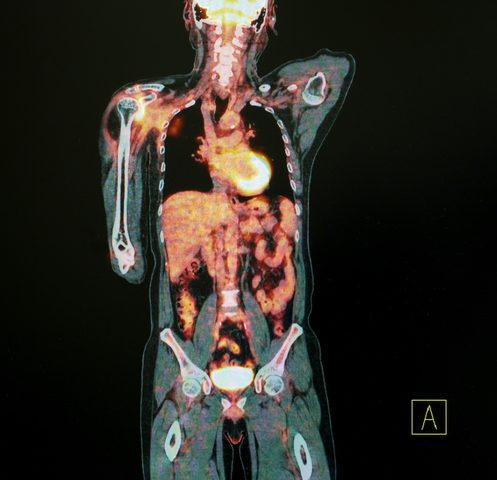A new PET imaging agent known as Carbon-11 labeled sarcosine, or 11C-sarcosine, detects prostate cancer better than the current agent, 11C-choline, University of Michigan researchers report.
PET is short for positron-emission tomography. The imaging technique uses radioactive agents, or tracers, to try to identify diseases in a patient’s body. This is usually done by looking at metabolic processes — that is, the way the body converts food to energy — which are often distinct in cancer and healthy cells.
The Michigan team’s study, published in The Journal of Nuclear Medicine, was titled “Preclinical evaluation of 11C-sarcosine as a substrate of proton-coupled amino acid transporters and first human application in prostate cancer.”
Prostate cancer cells disrupt several metabolism pathways and burn more amino acids than normal prostate cells. This leads to higher levels of sarcosine — a compound the body produces as it creates choline and glycine amino acids — in prostate cancer tissue than in normal prostate tissue.
Because sarcosine levels increase during prostate cancer progression, higher levels are associated with tumor aggressiveness and growth.
Solid tumors produce substances known as PAT molecules that transport sarcosine into cancer cells. This means that tracing sarcosine is a good way for a PET imaging system to track prostate cancer.
The Michigan researchers decided to compare sarcosine’s ability to detect prostate cancer cells with 11C-choline’s. Although a 11C-choline tracer can detect intermediate- and high-risk prostate cancers, it is unable to detect many low-risk cancers.
11C-sarcosine did a much better job of detecting prostate cancer in mice than 11C-choline, the researchers discovered. The tracer also generated high-contrast images of a prostate cancer patient, they said.
Because PAT transports 11C-sarcosine into cancer cells, and sarcosine levels are higher in the cells, the study offered the first evidence that PAT production is higher in prostate cancer cells than in normal prostate cells, Dr. Morand Piert, a University of Michigan radiology professor, said in a news release.
This means that 11C-sarcosine could be used to track the activity of PAT transporters as well, researchers said.
PATs activate an important cancer signaling pathway, known as the mTOR1 pathway, that certain drugs target. So scientists may also be able to use 11C-sarcosine to visualize how the drugs are working, the team added.

